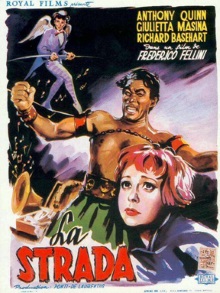
Once again I must confess that not only is this the first time I’ve written about a Federico Fellini film in this blog, it’s also the first time I’ve ever watched a film by this grandmaster of cinema. At least La Strada makes for a great pick to start things off with. It received a mixed reception when it was released but over time its reputation improved until it is now widely considered one of the greatest films ever made. Moreover, Fellini himself came to see this as his most representative work though directing it was an exhausting experience for him.
My wife notes that Fellini loves to make movies about the circus and indeed all of the characters in La Strada are circus performers. Fellini’s own wife Giulietta Masina plays what is apparently her most iconic role: a young woman named Gelsomina who comes from an impoverished family living by the sea. Her mother effectively sells her to a travelling strongman Zampanò, played by Anthony Quinn, and thus she becomes a performer. She learns to play the drum and later the trumpet, a bit of dancing and her natural disposition is a perfect fit for clownish antics that delight children. Another major character is the Fool, a high wire artist played by Richard Basehart who can’t resist teasing Zand infuriating Zampanò whenever they happen to meet.
La Strada doesn’t have an overly complex plot. It’s just the story of a naive and directionless young girl and her relationship with the brutish and domineering Zampanò. Despite her initial inexperience, she comes to love performing and the travelling life. She also feels an attachment to Zampanò though she is confused about how to characterize the relationship. In one pivotal scene, The Fool tells her that everything in the universe has a purpose, down to the smallest pebble, even if we can’t know what it is. Yet whenever her spirits rise, Zampanò never fails to send her crashing back down again with his primitive wants and crass ways.
The otherwise unremarkable story is livened up by how it is told amidst the circus scene with its attendant theme of using their finely honed showmanship to earn a living. As unsympathetic a character as Zampanò is, you can’t help but feel sorry for him as he goes from place to place performing his one single trick of breaking a chain with his chest muscles over and over again. The film is in effect a microcosm capturing the full range of human emotions, which might be why Fellini thought this could represent his work as a whole. As such, the circus setting with its theatricality is a natural fit as a mirror for life itself.
Masina is utterly fantastic in this film and completely owns the camera with the expressiveness of her face. The use of a musical leitmotif at first for The Fool and then later for Gelsomina herself is great use of the technique. Quinn and Basehart too are so perfectly suited in their respective roles that it seems unbelievable that both are Americans who don’t speak Italian at all. About the only flaw here is that the sound isn’t always synchronized with the images that we see so much so that it jars you out of the scene.
There’s nothing showy about this film. It looks like a simple story with competent but unspectacular cinematography. Yet everything comes together as a harmonious whole in a way that makes watching this a powerful experience. Its simplicity understates the tremendous amount of painstaking work that Fellini put into the work to make sure that everything complies fully with his vision. I guess this is why he is considered a grandmaster.